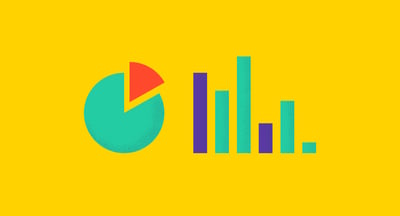Branding is more than striking the right creative note.
The rise of the internet and digital marketing has unleashed new possibilities for brand marketers. Before the internet, brands were built in boardrooms and involved mass advertising to reach the public.
Now? It's easier than ever to learn who your target audience is and what they think of your brand using technology like brand intelligence software. Brands have immediate access to customers through social media channels, email marketing, and other digital platforms.
However, that immediate access also comes with increased competition. It's easier for buyers to research their favorite brands before they buy. And the concept of brand loyalty has wavered as customers have more purchasing options.
Top branding statistics
- The aggregate value of the 100 most valuable brands worldwide was $8.3 trillion in 2023.
- In 2024, Apple overtook Amazon's position as the most valuable brand in the world.
- Hyundai is the most misspelled brand in the world, followed by Lamborghini.
- Over 80% of firms believe that their CEO understands how important branding is.
- Only 20% of businesses consider branding to be their top marketing spend.
If you want to master the art of building a great brand, understanding how customers perceive brands is crucial. Let's examine some of the most important branding statistics.
General branding statistics
Before you can jump into the nitty gritty of how a brand impacts each part of your business, it’s important to understand the branding landscape. Here’s a snapshot of the current branding ecosystem and what you’ll need to do to stand out.
- The top five most valuable brands in 2023 (measured in U.S. dollars) are Apple ($1 trillion), Google ($753.5bn), Microsoft ($712.9bn), Amazon ($576.6bn), and McDonald’s ($221.9).
- Five newcomers enter the Top 100 brands, including Lululemon (No.92; $20.6bn) and Corona (No.100; $19.0bn)
- From across the 13 category rankings, Google Cloud, Booking.com, and Chipotle are amongst the fastest risers.
- The Business Technology and Services Platforms category has grown the fastest, increasing in total value by 45%, partly due to excitement around advanced AI
- Among the top 100 global brands, Tesla has experienced the highest value gain, currently valued at USD $66.2 billion.
- 88% of consumers claim authenticity is crucial when deciding which brands they like and support.
76.7%
marketers believe the purpose of branding is to differentiate yourself from your competitors.
Source: Revenue Marketing Alliance
- 77% of consumers prefer to shop with brands they follow on social media.
- Gen Z is 2x more likely than millennials and 3x more likely than Gen X to feel that brands have the power to make the world a better place.
- 76% of Gen Z consumers say they like buying from brands with a greater mission or purpose.
- 62% of consumers say that their purchase decisions are heavily influenced by a brand’s values.
- 53.3% of companies claim that lacking a budget keeps them from doing more to build their brands.
- The most popular brand-building activity is content marketing, which includes blogs, white papers, videos, and podcasts—but it’s not the most successful.
- 68% of people like reading about the brands they find interesting.
- 70% of consumers feel more connected to a brand when its CEO is active on social platforms.
B2B branding statistics
Does your branding strategy need to change depending on your audience? You bet. Business-to-business (B2B) brands are starting to see a shift in how consumers research and purchase products. If you manage a B2B brand, check out these statistics to see how you stack up.
- Microsoft is the most valuable B2B brand in 2023, valued at $137.5 billion. Amazon is second, valued at $70.6 billion.
- Deloitte was titled the strongest B2B brand globally in 2022, followed closely by EY and Petronas.
- 41% of B2B businesses conduct their brand marketing activities in-house.
$48.15 billion
is the projected B2B digital ad spend worldwide by 2026, up from $38.67 in 2024.
Source: eMarketer
- A Statista survey showed that 50% of B2B brands planned to boost their content marketing spend within 12 months.
- 52% of B2B buyers say they are more likely to buy from a brand after reading their content.
- 29% of B2B buyers visit only one page from the Google search results page.
- 35% of B2B businesses conduct their marketing activities in-house.
- On average, B2B organizations allocate only 8.7% of their total budget to marketing.
- 45% of B2B companies plan on increasing their content marketing spend within the next 12 months.
B2C branding statistics
Marketers at business-to-consumer (B2C) companies face a unique challenge when creating their brand. B2C customers value personalization and customer experience when choosing which companies to do business with. Here’s a look at some of the top B2C branding statistics your team needs to know.
- B2C consumers are 4 to 6 times more likely to buy from and advocate for purpose-driven brands.
- 77% of B2C consumers are likely to purchase based on a brand name.
- 62% of B2C consumers are more likely to click ads, social posts, and emails featuring customer photos than an image created by the brand.
40%
of shoppers say they need to buy from a brand five or more times before they consider themselves loyal.
Source: Yotpo
- 76% of B2C customers have purchased a product based on someone else’s recommendation.
- 83% of shoppers say loyalty programs influence their decision to buy again from a brand.
- 59% of consumers would wait for products to be back in stock at their favorite brand's store or website rather than shopping somewhere else.
- 90% of consumers are willing to share their behavioral data if additional benefits are provided that make shopping cheaper or easier.
Employer branding statistics
Think your employer brand only affects revenue? Think again. Your employer brand can impact everything from your online reputation to employee retention and the kind of candidates applying to work at your company.
- Job candidates are two times as likely to accept cold emails when they have already interacted with a brand.
- 70% of customer brand perception is determined by experiences with people
- 65% of firms reported increased brand recognition on implementing an employee advocacy program.
- 52% of brands regularly use employee-generated content (EGC) in communication channels.
82%
of candidates consider employer brand and reputation before applying for a job.
Source: CareerArc
- 77% of organizations see employer branding as an integral and crucial part of their overall business strategy.
- 80% of talent acquisition managers believe employer branding plays a significant role in the ability to hire top talent.
- Improving employer branding can reduce staff turnover by 28%
- Companies with positive brands get two times as many applications as companies with negative brands.
- 40% of Millennials say market reputation has the biggest influence on their impression of an employer.
- 55% of job seekers abandon their applications after reading negative reviews about a brand.
- 62% of employers share that employer branding is one of the most critical HR functions in their organization.
Personal branding statistics
Building your personal brand is much different than building a corporate brand identity. Whether you’re a solopreneur, a freelancer, or just someone looking to make a good impression, these personal branding statistics can help guide you.
- 28% of hiring managers say the most effective resources for finding candidates are their online profiles.
- On average, employees have 10 times more followers than their company's social media accounts.
- 77% of shoppers are more likely to buy from brands that personalize their shopping experience.
80%
of recruiters consider personal branding important when evaluating job candidates.
Source: The Manifest
- 33% of brands use paid advertising to personalize experiences and boost brand awareness.
- 86% of shoppers prefer an authentic and honest brand personality on social media.
- Sales reps who use social media as part of their sales techniques outsell 78% of their peers.
- 82% of customers trust a company when their senior management members are active on social media.
- 40% of consumers actively research brand guidelines, values, and practices.
Brand design statistics
Do things like colors and logo design really impact your brand image? Can the right font make or break your sales goals? While branding is so much more than just the visual elements, there’s evidence to suggest the aesthetics of your brand can impact your business.
- Consumers voted Apple, Nike, Coca-Cola, Google, and FedEx to have the most visually appealing logos.
- A signature color can increase brand recognition by 80% (like Starbucks green or IKEA yellow and blue).
- The trademarking process for a logo takes anywhere between six to nine months.
40%
of Fortune 500 companies use the color blue in their logos.
Source: Website Planet
- 67% of small businesses will pay $500 (or more) for a logo.
- The right color can improve readership by 40% by making messaging easier to read and more visually appealing.
- It only takes 50 milliseconds for consumers to judge the visual appeal of your brand.
- 90% of the information transmitted to the brain is visual.
- 90% of snap judgments consumers make about products have to do with color.
- 72% of the best brands are named with made-up words or acronyms.
Digital marketing and branding statistics
Looking for a way to promote your brand to the masses? Social media, search engine optimization (SEO), content marketing, and other digital marketing tactics can be the best way to cut through the noise. But before you start building your online brand presence, check out these statistics for guidance.
- 64% of consumers have tagged a brand or used their hashtag on social media.
- 45% of people will unfollow a brand due to high self-promotion.
- 6 in 10 marketers feel their audience engages more with user-generated content, but only 41% of marketers regularly use it in their marketing channels and communications.
85%
of consumers use social media to conduct research about new brands.
Source: Tintupt
- 71% of marketers plan on showing more diversity, inclusivity, and accessibility in their brand content.
- Nearly 52% of people say they post about purchased products on social media at least once a month.
- Consistent brand presentation across all platforms increases revenue by up to 10-20%.
- 91% of people want to see more videos from brands.
- 64% of consumers make a purchase after viewing a branded social video.
- 42% of online shoppers base their opinion of a website on the overall design alone.
Branding and customer trust statistics
Customers are increasingly looking to do business with companies that give back to the community and offer increased transparency. But how much do these efforts impact your bottom line?
- 72% of people want brands to positively contribute to society, while 64% want them to connect with their customers.
- 58% of consumers say they’ve left an e-commerce store without purchasing because the website didn’t contain any customer reviews or photos.
- 76% of consumers want brands to prioritize customer support and respond quickly, with 69% expecting a response within the same day of reaching out.
70%
of consumers expect personalized responses when they reach out to brands on social channels.
Source: Sprout Social
- 58% of consumers view user-generated content as the most authentic form of content
- 68% of customers will share information with their favorite brands in exchange for personalized loyalty experiences and rewards.
- 84% of shoppers agree to buy from brands they share values with.
- 81% of consumers consider data transparency important for trusting a brand.
- 66% of people define feeling connected to a brand when it gains their trust, while 53% define it as having aligned values.
Don't blend in; brand out!
As long as businesses create products, branding will arguably be the most important aspect of marketing. If one main point were made clear from these statistics, every consumer group would have a different preference. Ensure you fully understand who your target market is before you begin branding your products and services to appeal to them.
Need help in kicking your brand into high gear? Contact the best branding agencies to develop the most effective strategies for your business.
 by Lauren Pope / December 3, 2024
by Lauren Pope / December 3, 2024
 by Alyssa Towns
by Alyssa Towns
 by Lauren Pope
by Lauren Pope
 by Hannah Tow
by Hannah Tow
 by Alyssa Towns
by Alyssa Towns
 by Lauren Pope
by Lauren Pope


